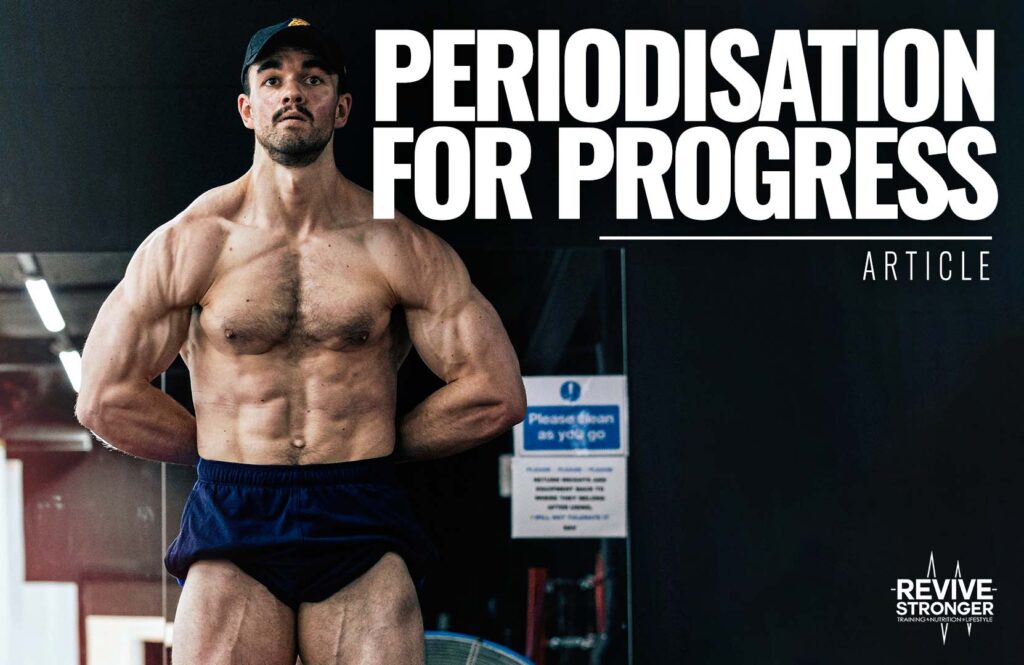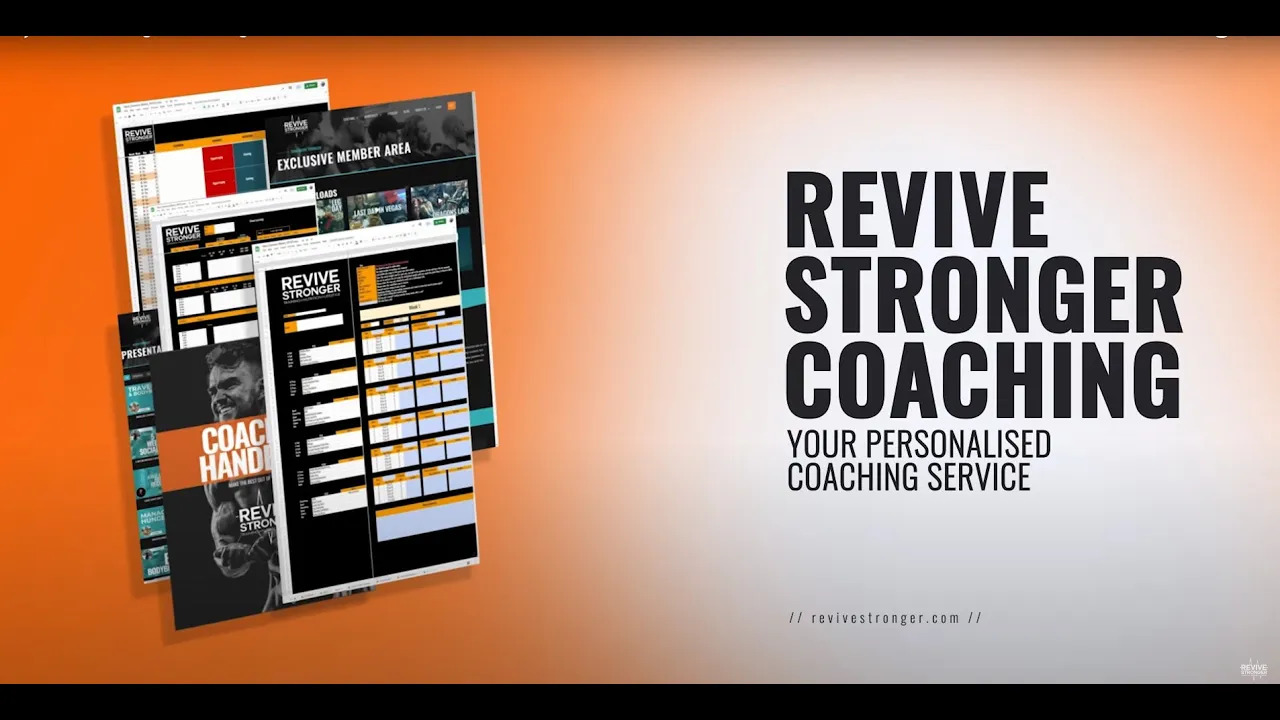
Revive Stronger
Periodisation for Progress

Do you exercise?
Or…
Do you train?
You might be sitting thinking; what is the difference? Well there is a big one, trust me.
People who exercise don’t progress, they go to the gym, pick up a few weights, jump on some cardio machine, do some stretches and leave. They might go three times a week, they might go five times a week, they don’t have a plan, they just exercise. There is nothing wrong with this, in fact exercising is good, it helps to keep us healthy, but exercise is not progressive, there is no improvement, no plan or movement to a goal.
Don’t get me wrong, you can still exercise really hard, feel obliterated and exhausted. But if you don’t have a plan in place you’ll burn out, and regress. When we are new to training we can get away with this approach, because our bodies can adapt quickly, however we will soon plateau.
You see I train, all my clients train, and if you want to progress towards your goals, you too want to train.
Table of Contents
What is Training?
So we know if you’re after results, exercising isn’t the way to go, you want to train. And as alluded to earlier that means you need to have a plan in place. If you’re like me then you want more than to just burn calories or maintain a fitness level, you want to get strong and jacked.
[bctt tweet=”I Train, I seek to escalate my physical capabilities beyond the norm”]
When you train you take a long-term view, you don’t look at what you’re doing today in isolation, you look at what you train each session as full-filling a need for an objective. To quote Mark Rippetoe directly “training is physical activity for purposes of satisfying a long-term performance goal”. So each session you do in the gym builds towards the next, there is a process, you don’t just go in the gym to get a sweat on, feel the burn and get tired, you go in there to help take you along your journey to your overall goal.
If you just want to lose weight, then you’ll be OK just going in and doing exercise, but if you want to grow appreciable muscle and develop formidable strength you won’t get there by exercising.
I’m going to put it out there and say most people exercise, if you’re reading this and you don’t just exercise, well done, you’re bettering yourself with each session that builds to the next. If you are just exercising, you don’t have a plan over and above feeling tired, you need to start training if you’re serious about wanting results.
How to Start Training
If you want to start training, good on ya! I want to help you out, because training takes time and dedication, remember it is about the long-term objective, not what you’re accomplishing in the here and now. So you need to be patient, if the plan calls for you to train 5×5 on squats and you decide you wanna test your 1 rep max, you have failed, broken the plan and it won’t work for you.
[bctt tweet=”for the person who trains, each piece of the puzzle fits into a larger picture”]
Training means planning, you need to plan not only what you’re going to do in each workout, but also what you’re doing each week, each month and why you’re doing it, there needs to be logical progression. This longer term perspective is called Periodisation.
Periodisation refers to a division of the training season, into smaller and more manageable intervals with the ultimate goal of reaching the best performance results during the primary competitions of the season. Basically you don’t go to the gym and do the same exercises, for the same reps and sets every time, you change exercises, loads, frequencies and methods over the training cycle.
Periodisation
Periodisation is regarded as one of the most complex problems when it comes to training. There are various aspects one wants to improve when training such as; strength, muscle growth, power etc. To really improve on one aspect, we need to focus on it, however this means we are not training the others. Say we train for hypertrophy, each week we are not training for strength we could potentially be losing some of our strength adaptations. So a good periodisation plan is essentially a trade-off between conflicting demands. You train each aspect enough, without allowing the others to de-train, thus allowing you to continue to progress.
These aspects and training itself is organised within different time scales; microcycles, mesocycles and finally the macrocycle. The microcycle normally represents a week of training, a mesocycle is a group of microcycles that are focussed on developing a certain training aspect and are typically a month in length, finally a macrocycle encompasses all of this and is the overall training plan, this could be 12 weeks all the way up to years in length.
Above is a typical example of this long term view; you have your macrocycle which lasts a year, this is made up of many mesocycles which here are a month in length, and finally you have your microcycles which make up the mesocycle and in this example constitute one week.
The greatest gains in anyone training area (strength, hyperophy etc.) can be achieved only if we concentrate on this type of training for a reasonably long period of time. Thus, we should train with some sort of sequential pattern, so that each aspect builds towards the next, and this is called linear periodisation. For example, a strength athlete focusses on building muscle first, then he trains for strength, to get the accrued muscle strong, and finally the athlete goes into a peaking training cycle, to lift maximal loads.
Another method of periodisation is called non-linear, instead of focussing on one aspect at a time, you train each simultaneously. Whether it be within the same workout, the same training week or training month, you are aiming to improve on various aspects at once e.g. stronger, fitter and more muscular. I will note however, that every periodisation approach will be linear in its overall method, because the trend will still be up, as we progress.
Stress, Recover, Adapt (SRA)
When we train we are stressing our body, if we stress it enough our body will be forced to recover and then adapt to the stress by returning past it’s pre-stressed state. It’s like someone hitting you in the stomach, the punch is the stress, you then get your breath (recover), and put your hands up in defence (adapt). This adaption to stress is your bodies way of surviving in its environment.
However, imagine this, if you get punched in the stomach, you recover and adapt, next time that punch comes, if it isn’t any harder, faster or different, you’re not gonna need to recover or adapt again. Just in the same way with our training, we need to keep causing new increasing stress to keep progressing. Think about it, you’re much stronger now than you were when you started, you’re probably bigger too, this because your body has recovered and adapted. To continue to see progress you have to lift heavier weights and do more of it. It’s easier to get better at something, when you’re not very good. So as a new lifter you may have been improving week on week, whereas now you have a few years under your belt, you’re lucky to see improvements every few months.
This is because of The Law of Diminishing Returns, which in short means that the more you do something the less you get from it. This is why we can get away with exercising at first, but then must train later on. We are not progressing week to week, so trying to hit Personal Bests every workout isn’t gonna happen. We need to periodise, work with sub-maximal loads, adding weight on a predetermined schedule. This schedule, or macrocycle if you will, has been split into mesocycles that drive progress.
Right, so we know that in order to progress we need to cause enough stress, allow ourselves to then recover so we can adapt and improve. As we get better at training, it gets harder and harder to progress, due to the law of diminishing returns, thus we need to plan our training, via periodisation. The way we periodise will therefore depend on how long we have been training (training age), in Practical Programming Mark uses the terms ‘novice‘, ‘intermediate‘ and ‘advanced‘ to describe the trainee with respect to the time it takes for recover from a stress induced by training. This can be seen in the above graph in which as you become more advanced overtime your ability to adapt to training goes down, your strength comes up and the need for more complex training methods also increases. This is why when you start training you see performance increases easily without complex methods, however as you develop progress slows and the need for training complexity rises, this is where periodisation comes in.
Furthermore, different exercises and training aspects take different amounts of time to recover from. For example, training your technique isn’t very stressful, thus you can recover and adapt relatively quickly. Also training your biceps, a small muscle group doesn’t cause masses of stress, so recover fast. Whereas, when you train close to your maximum for a lot of reps this creates a large stress and therefore takes more time to recover and adapt from. In the same way the deadlift is a large compound movement, using a lot of musculature and therefore causes a much larger stress and takes more time to recover from.
So it is important to give enough rest between the aspects we are training for and the exercises chosen. You wouldn’t want to do heavy deadlifts on Monday and then again on Tuesday, you simply won’t have recovered and adapted in time. However, in the same instance, you don’t want to wait too long, so if you deadlifted heavy on Monday it’s likely you’ll be recovered by the next week, so don’t wait another week to train the deadlift. You want to line up the next training session at the adaptive peak of the last training session. So for the deadlift or maximal lifting this might be once every week, whereas for the biceps or technique work, this might be every other day. This is depicted below.
I am going to repeat this again, because it is important; you want to line up the next training session at the adaptive peak of the last training session. Because, as you have seen our training age also impacts this, if we are a novice, intermediate or advanced lifter, our SRA length will differ, even for the same training aspects or movements. Just think, as a novice a heavy deadlift on Monday might be 100kg, because you’re new to training, you adapt quick, and by Friday you can hit a Personal Record (PR) of 105kg. Whereas, if we take an intermediate like me, if I was to do a max deadlift on Monday of say 230kg, I’d be lucky if I could hit this again by Friday, let alone hit a PR. I would need a lot more time before I had adapted to the stress and could hit a new PR. So your training age will also impact the frequency that you want to lift.
These are what I see as the most important things to bare in mind when setting up a training plan. There are other aspects that impact our SRA such as muscle fibre type, but that is beyond the scope of this article. Just know that your training age, what you are training for and the exercise you’re doing will impact when next you should train that again.
- Newer Lifter –> Higher Frequency
- Compound Movements –> Lower Frequency
- Isolation Movements –> Higher Frequency
- Maximal Lifts –> Lower Frequency
- Technique & Hypertrophy Work –> Higher Frequency
Taken from The Scientific Principles of Strength Training “At it’s core SRA means that you wanna hit it hard in training and then take the time to recover properly before hitting it hard again”. As you can see the frequency at which you hit it hard will depend on multiple factors. To make things simple think of high frequency as training a muscle group 3 to 5 times per week and lower frequency as 1 to 3 times per week. So a new lifter might be able to train their biceps 5 times per week for hypertophy and do a max squat up to 3 times per week, whereas a advanced lifter may hit their biceps just 3 times per week and lift a max squat once in that week.
Setting Up Your Periodisation Plan
OK so I have covered a lot in the above, so I will make it easier by summarising what we know in a few bullet points:
- If we want to see continued progress we need to Train
- In order to Train we need to have a plan
- This long-term plan is called periodisation
- We periodise by training for different goals at difference times through our mesocycles
- These can be set up in a linear (sequential) or non-linear fashion
- When planning we need to respect our Stress Response Adaption (SRA) time
What I have yet to touch on is how do you train for these different goals? As my audience are mainly guys looking to get jacked and strong this is going to be my focus. I will note right here and now that there is overlap between each of these areas, what I mean by that is when you train for size, you will also gain strength and when you train for strength, you will also gain size. However, the main aim for your training will be the area you will see most improvement, so when you train for strength you will get stronger much faster than when you train for larger muscles.
Training for Hypertrophy (Muscle Growth)
Current research suggests hypertrophy is produced via three main mechanisms; mechanical tension, metabolic stress and muscle damage. Each is produced through different ways of lifting, and to build the most muscle possible it is important to achieve all three. I go over this in a load of depth in Get Big, Stay Lean but here I am just going to say you want to lift heavy, get a pump and vary your exercises now and then. However, remember you can lift heavy, get the biggest most knurly pump ever and vary your exercises each month, but you will not grow unless your progressively overloading your muscles.
For simplicities sake I am going to use the recommendations from The Scientific Principles of Strength Training:
- Intensity: 60% to 70% of your 1 rep maximum
- Rep Range: 6 to 10
- High Volume
You’ve got a basic outline of how you therefore train for size, you’ll want to then periodise this sort of training and you can do this in many many ways. As said above you do this by focussing on it in a mesocycle, which at a minimum is 2 weeks in length. For ease of discussion I am going to give you a nice month hypertrophy mesocycle that follows linear periodisation:
Weeks
- 3×10 @ 65%
- 3×10 + 2.5kg on last week
- 3×10 + 2.5kg on last week
- 3×5 @ 60% (deload)
Assuming the same lifts were done each week that would be a real simple linear periodisation approach that would probably only be suited for a novice lifter. As you can see the load you are using is progressed week to week, so volume and intensity is going up before a deload in week 4. I won’t go into how you would set up each individual training session, as that is beyond the scope of this article, but I will come to that in future.
Training for Strength
When we are directing our training for strength the goal is to increase our ability to produce force. To best develop strength we therefore want to lift heavy and I am again going to use the recommendations from The Scientific Principles of Strength Training:
- Intensity: 75% to 85% of your 1 rep maximum
- Rep Range: 3 to 6
- Medium Volume
So just like hypertrophy training you can programme this in multiple ways, but as we have been going with the simple linear approach I will stick to that with Strength mesocycle:
Weeks
- 3×5 @ 75%
- 3×5 + 2.5kg on last week
- 3×5 + 2.5kg on last week
- 3×2 @ 70% (deload)
Again assuming the same lifts were done each week that would be a real simple linear periodisation approach that would probably only be suited for a novice lifter. As you can see the load you are using is progressed week to week, so volume and intensity is going up before a deload in week 4. Again I realise I have now introduced the concept of deloads without much explanation, they are in short a period of unloading so you can allow your body to recover and adapt. I will do an article in future in which I go over the importance of these in much more detail.
Your Plan
So you have an understanding that you can no longer do the same thing session to session and see results, you need a plan. This plan is called periodisation and is made up of a macrocycle, mesocycles and microcycles. We know that we cannot now progress at everything at once and so need to set up mesocycles that direct us towards a specific training goal.
Training too many abilities during the same workout, microcycle or mesocycle lesson its effectiveness. Two to Three would be the maximum, so you could tackle both strength and hypertrophy concurrently, utilising undulating rep schemes similar to what I use in Get Big, Stay Lean, this would be suitable for an intermediate who cannot progress linearly week to week.
Above I have provided two simple linear mesocycles for both strength and hypertrophy, you could move from one to the next and therefore rotate every month, or you might be better off running longer blocks of training say 2 months of hypertrophy followed by 2 months of strength. That will be dependent on your goals and level of training development.
The general idea in planning workouts and training days is to do as much as you can while remaining fresh. This is why having an idea behind the SRA is important and why exercising doesn’t drive results. Just like during a heavy training session you need to rest more between sets you need to rest more between heavy workouts. If you don’t rest enough you are going to train with fatigue, which will reduce training volumes and therefore progress.
A good periodisation plan is a subtle trade-off between conflicting demands. The long standing linear approach tackles this by focusing on training aspects sequentially e.g. hypertrophy block, then a strength block. A more recent approach is a non-linear method by which you still progress in a linear fashion overall but there are more frequent intermittent changes in training targets e.g. hypertrophy and strength trained in the same mesocycle or even microcycle. Both have their merits and downsides, and to be honest you’re doing well if you follow a plan, so I wouldn’t sweat it between the two. If you are progressing you’re doing a great job, I will however in future discuss both in greater detail.
[bctt tweet=”There is no best programme for all, there is however a best programme for you.”]
All humans are different, and therefore we will all respond in different ways to training. Use the above and start think about planning your training across different time scales and strive for a measurable improvement. In future I will discuss the use of conjugate and undulating and how they can be used in your plan.
Resources
- V, M Zatsiorsky. W, J, Kraemer. Science and Practice of Strength Training. 2006
- M, Rippetoe, A, Baker. Practical Programming for Strength Training. 2009
- M, Israetel. J, Hoffmann. C, W, Smith. Scientific Principles of Strength Training. 2015
We are a personal coaching service that helps you achieve your goals. We want you to become the best version of yourself.











